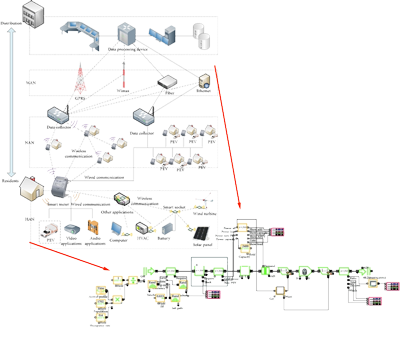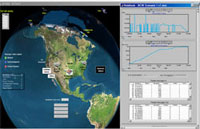Communications systems are often large and complex with many interacting parts and elements. To accurately predict and deliver a high quality of service, network system designers and operators increasingly turn towards computer models of their systems to simulate real world operational conditions and gain insights into usability and requirements prior to final product sign-off.

Network
Controllers
Use ExtendSim to simulate network controllers. An ExtendSim model was instrumental in the design process for the chip that controls Apple's AirPort.
Deployment of digital smart grid sensing, communication, and control technologies that improve electric grid security, reliability, and efficiency is growing exponentially. ExtendSim is being used to dynamically monitor grid operations - identifying appropriate security controls based on parameters and constraints then simulating mission assurance indicators before and after defense actuation to gauge effectiveness.

RF & Microwave
Receivers
Simulation of RF and microwave receivers from a system design viewpoint.
The emerging National Healthcare Information Network (NHIN) relies on multiple disparate clinical specialists and care delivery providers, each using specialized computer systems for optimal clinical data. Sharing of this information via use of a telemedicine system can present unnecessary system constraints on network bandwidth. ExtendSim has helped characterize the behavior of various network architecture configurations under challenging ranges of operating conditions providing an invaluable predictive assessment of the feasibility of various approaches.
ExtendSim for Communication Networks
- Reliability and fault tolerance.
- Orbital and antenna modeling.
- Data processing centers
- Command and control centers.
- Airborne and ground communication systems.
- Operating and tracking air-to-air pulse radars.
Who is Using ExtendSim for Network Modeling
 Northrop Grumman Mission Systems developed tools for the simulation and visualization of National Polar-Orbiting Observation Environmental Satellite System (NPOESS) weather satellite data collection and processing systems. The model simulates multiple orbiting weather satellites, data retrieval through global receptors, and weather product generation and distribution. The simulations are used to size the architecture and evaluate cost/performance trade-offs.
Northrop Grumman Mission Systems developed tools for the simulation and visualization of National Polar-Orbiting Observation Environmental Satellite System (NPOESS) weather satellite data collection and processing systems. The model simulates multiple orbiting weather satellites, data retrieval through global receptors, and weather product generation and distribution. The simulations are used to size the architecture and evaluate cost/performance trade-offs.- Communication service providers.
- Government entities.
Case Studies
Peng Han, Jinkuan Wang, Yinghua Han, & Yan Li
School of Information Science and Engineering, Northeastern University, Shenyang, China
With the development of smart grid technology and the increase of the global resident Plug-In Electric Vehicle (PEV) market in the near future, the interaction between limited distribution grid capacity and uncontrollable PEV charging loads can lead to violations of local grid restrictions. And the proper model charging scheduling mechanism is the key to assess and satisfy various resident charging requirements to help in optimizing utility utilization. In this paper, the distribution grid profile model with PEV charging power is firstly constructed for the purpose of studying resident PEV charging impact on the distribution grid. To better reflect the actual impact of PEVs, real data on driving behaviors, vehicle characteristics, and electricity loads were used to generate the model. Furthermore, an improved queuing-theory-based scheduling mechanism is proposed, the distribution grid communication structure and the algorithm are illustrated, and computer simulations are demonstrated to verify their performance. Results show that the proposed scheduling mechanism will enhance the distribution grid flexibility to meet various charging requirements while maximizing grid capacity.
The Internet Corporation for Assigned Names and Numbers (ICANN) Board, the Security and Stability Advisory Committee (SSAC), and the Root Server System Advisory Committee (RSSAC) commissioned a study of the potential impact on the operation of the root server system of adding IPv6 address records, IDN top level names, other new TLDs, and new records to support DNS security to the root zone.
The DNS Root Scaling model developed by TNO shows how the different parts of the root server system are related and how changing something in one part affects each of the other parts. The model can be used to quantitatively assess – and therefore prioritize – risks involved when changing the value of one or more variables (e.g., the rate at which new TLDs are added to the root, or the expected frequency of emergency key rollover events in a signed root) on each of the component of the root server system. Partly on the basis of the initial results, ICANN has been advised to temporize and monitor the developments already initiated.
Jim Walsh, Jeff Roberts, and Wayne Thompson from Parsons
Presented at the 2005 International Command and Control Research and Technology Symposium
NETE is a medium fidelity, end-to-end model used to analyze the Global Information Grid (GIG) infrastructure and Net-Centric Warfare (NCW) related CONOPS and design concepts. The ExtendSim based NETE model provides a means to assess the ability of a defined network to support a concept of operations with resource management to allow the assessment of latencies under varying loads. NETE calculates the impact of network ‘jitter’ on mission timelines. This model has been used to analyze Transformational Communications supporting missile search operations, missile defense engagement operations, architectures for Responsive Space Operations and Homeland Security.
US Tech Interactive
March 1999
Simulation Streamlines Production, Shaves Cost describes a digital wireless communications products and technologies manufacturer that streamlines its equipment manufacturing processes and improves inventory control, generating significant cost savings, with simulation.
The United States Air Force, in accordance with the Department of Defense's mission to modernize its processes, systems, and information flows, began an effort to replace legacy systems with two Enterprise Resource Planning (ERP) systems. Nova Technology Solutions (NovaTech), an Information Technology (IT) and Analytics firm, recognized the Air Force's need for a repeatable, reliable, tool to aid decision making during the planning, installation, and sustainment of these ERP systems, thus proposing the use of modeling and simulation.
ExtendSim was used to create a simple simulation model to analyze the impact of ERP increased workload on network performance by simulating the flow of data packets, specifically at the Air Force Service Delivery Points (SDPs). Results showed a 15% increase in current workload (or current network traffic) will cause a 250% increase in end-user response time (Fitzgerald & Harper, 2008).
Tiffany Jill Harper, thesis submitted in partial fulfillment of the requirements for the degree of Master of Science in Engineering, Wright State University, 2008
Further enhancements were made to the NovaTech model by Tiffany Jill Harper for a thesis submitted for the degree of Master of Science in Engineering at Wright State University. Her thesis showed a 98%, 209%, and 352% increase in response time when the current workload is increased by 10%, 20%, and 30%, respectively. In an experiment investigating the impact of capacity expansion in the model with the double resource SDP, it was determined that for a 30% increased workload a 42.5% increase in SDP bandwidth capacity at the base hosting the application server resulted in a 75% decrease in average end-user response time during the peak traffic hour.
Ahmed Aziz Ezzat, Julia El Zoghby, Mohamed El Ahmar, Nermine Hany, Azmy Mehelba, and Ezz Abou Emira of the Arab Academy for Science, Technology, and Maritime Transport
July 2013
Used ExtendSim to develop a simulation model representing a smart traffic control system in order to evaluate its correspondent performance compared to the current situation. Optimization using simulation methodology was employed to reach the best possible traffic light timing and to study the possibility of applying FPGA’s for the control of traffic systems.
Peter Turner, NetMod
October 14, 2014
After attending the ExtendSim Masterclass "Modeling Reliability with ExtendSim" presented by Anthony Nastasi, Peter Turner of NetMod thought it would be interesting to encode a Monte Carlo solution to the source-terminal availability problem in an ExtendSim custom block. One method of modeling reliability in ExtendSim Mr. Turner learned from the MasterClass was to set up a kind of reliability graph. He then extended the block to provide a reliability option. His simple test model is posted at www.netmod.co.uk/?p=331
Videos

Satellite Orbiting and Communication Modeling
This SimCast of a Simulation Master Class looks at an orbital model, data communication model, and a detailed ground processing model. Doug Shannon of TASC/GreenDart, Inc. and Richard Marymee of GreenDart, Inc. examine polar orbiting weather satellites, stored sensor data, communication links to global receptors, and sensor data retrieval in ExtendSim models. The data retrieval model includes lost data and data recovery due to a rain attenuation model. The ground model is a process flow of sensor data executing simulated weather algorithms on shared data processors.





 Download Article
Download Article







